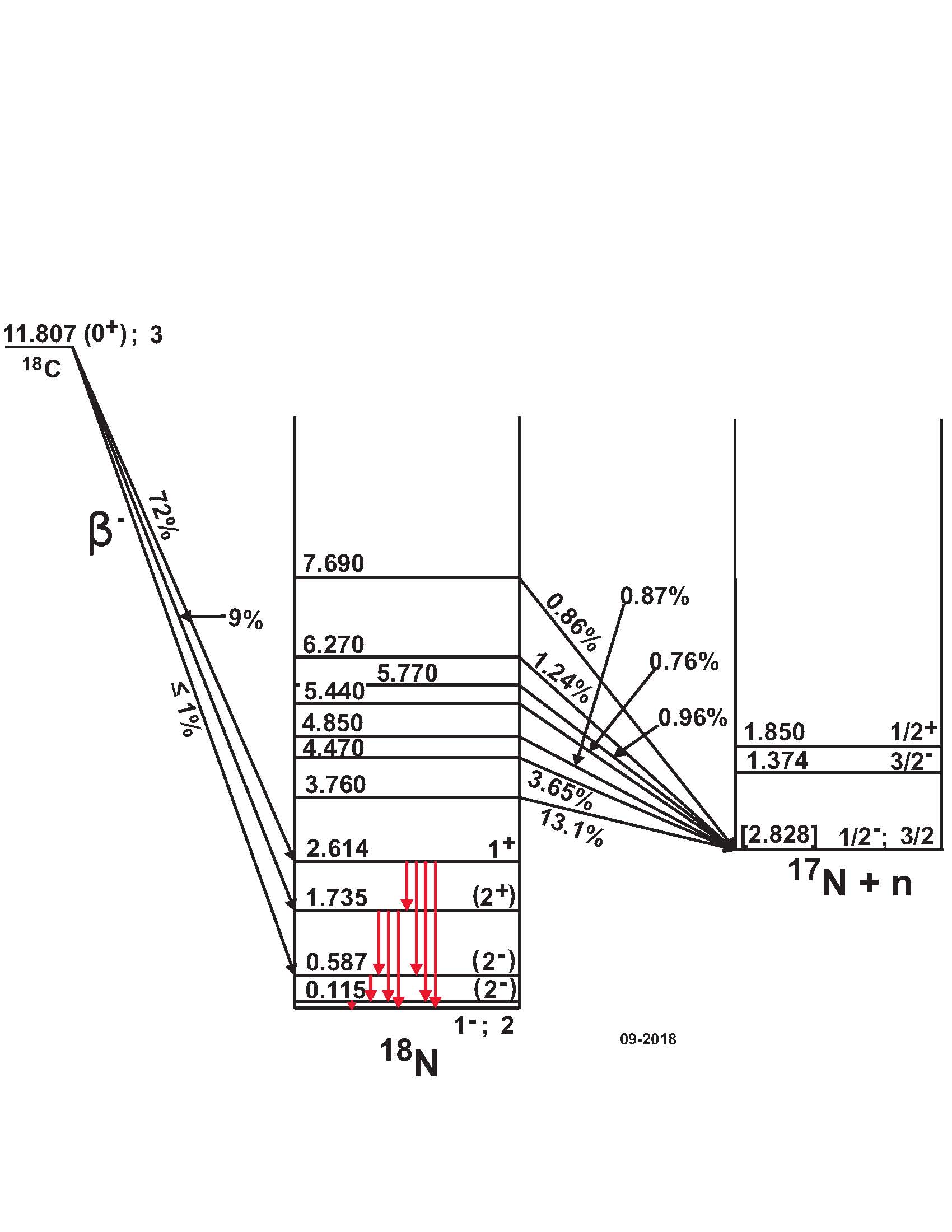


| Recommended value (July, 2015): | 92 ± 2 ms | |
| Summary Table of Uncertainty Analysis: |  (PDF) (PDF) |
|
| Measured values: | 92 ± 2 ms | (1995SC03) |
| 95 ± 10 ms | (1991PR03) | |
| 92.9 ± 5.3 ms | (1994RE1R: see also 94 ± 27 ms in (1991RE02) and 92 ± 5 ms in the | |
| unpublished private communications of (2008REZZ)/(1995REZZ).) | ||
| 78+20-15 ms | (1989LE16) | |
| 66+25-18 ms | (1988MU08, 1987MU1J) | |
| Other Reviews: | 92 ± 2 ms | (2015BI05) |
| Decay to 18N* (MeV) |
Branching Ratio (%) a | log ft | Pn (%) | ||
|---|---|---|---|---|---|
| (1991PR03) | (1991PR03) | b | (1987MU1J) | ≈ 25 | |
| 0.115 | (1988MU08) | 25 ± 4.5 | |||
| 0.587 | ≤ 1 | ≥ 6.36 | ≥ 6.4 | (1989LE16) | 50 ± 10 |
| 1.735 | 9 ± 7 | 5.18 ± 0.78 | 5.2 ± 0.4 | (1991PR03) | 19 ± 5 |
| 2.614 | 72 ± 10 | 4.11 ± 0.22 | 4.08 ± 0.08 | (1991RE02) | 43.3 ± 6.5 |
| (1995SC03) | 21.4 ± 4.4 c | ||||
| a) (1991PR03), calculated with the hypothesis that there is no direct β-feeding of the 0.115 MeV level. The total probability of β decay to gamma emitting states plus to the ground state is Pγ = (81 ± 5)%. The β-delayed neutron probability is Pn = 1 - Pγ. |
| b) log ft's were recalculated by evaluators (1995TI07) and are slightly different from those in (1991PR03) due to use of level energies from Table 18.4 in (1995TI07) and Q-values from (1993AU05). |
| c) See the following table. |
![]()
| Elabn (MeV) | Ecmn + Sn a (MeV) | Branching Ratio (%) | log ft b |
|---|---|---|---|
| 0.88 ± 0.02 | 3.65 ± 0.02 c | 13.1 ± 1.3 | 4.55 ± 0.05 |
| 1.55 ± 0.02 d | 4.47 ± 0.02 | 3.65 ± 0.41 | 4.92 ± 0.06 |
| 1.91 ± 0.02 | 4.85 ± 0.02 | 0.87 ± 0.16 | 5.44 ± 0.09 |
| 2.47 ± 0.02 | 5.44 ± 0.02 | 0.76 ± 0.13 | 5.31 ± 0.09 |
| 2.78 ± 0.02 | 5.77 ± 0.02 | 0.96 ± 0.14 | 5.11 ± 0.07 |
| 3.25 ± 0.03 | 6.27 ± 0.03 | 1.24 ± 0.15 | 4.82 ± 0.06 |
| 4.59 ± 0.04 | 7.68 ± 0.04 | 0.86 ± 0.12 | 4.39 ± 0.06 |
| Total Branching Ratio (%) e | 21.4 ± 4.4 | ||
| a) For details see text in (1995SC03). |
| b) Assuming neutron decay to the ground state of 17N; for neutron transitions to excited states in 17N, the log ft values represent an upper limit. |
| c) The large branching ratio suggests a transition to the first excited state of 17N leading to an excitation energy of 5.13 MeV; for details see discussion in Section 4.2 in (1995SC03). |
| d) Γ = 180 + 40 keV. An unresolved doublet with En = 1.51 and 1.65 MeV cannot be excluded. This assumption would lead to excitation energies of 4.42 and 4.57 MeV and to branching ratios of 1.8% and 1.3%. |
| e) The errors of the total efficiency (10%), the background subtraction (15%), and the number of observed fl-decays (10%) have been added after summing. |
![]()
| 18N transitions (keV) | I (relative) a | Branching Ratio (%) b | ||||||
|---|---|---|---|---|---|---|---|---|
| Eγ | Ei → Ef | |||||||
| 114.9 ± 0.2 | 115 → 0 | 32 ± 1 | 100 | |||||
| 471.7 ± 0.2 | 587 → 115 | 15 ± 2 | 100 ± 16 | |||||
| 1734.8 ± 0.4 | 1735 → 0 | 25 ± 5 | 33 ± 8 | |||||
| 1619.9 ± 0.3 | 1735 → 115 | 25 ± 5 | 38 ± 9 | |||||
| 1147.8 ± 0.4 | 1735 → 587 | 17 ± 5 | 29 ± 10 | |||||
| 2614.2 ± 0.4 | 2614 → 0 | 100 ± 11 | 49 ± 8 | |||||
| 2499.3 ± 0.4 | 2614 → 115 | 41 ± 9 | 22 ± 6 | |||||
| 2025.3 ± 0.8 | 2614 → 587 | 7 ± 5 | 3 ± 2 | |||||
| 879.7 ± 0.2 | 2614 → 1735 | 44 ± 4 | 26 ± 6 | |||||
| 1374.0 ± 1.0 | β-delayed neutron emission | 24 ± 5 | ||||||
| 1849.9 ± 0.4 | β-delayed neutron emission | 11 ± 5 | ||||||
| a) The intensities have been normalized to 100 for the 2614 keV line. |
| b) The branching ratios are normalized to get 100% flux out of a level, taking into account corrections for summning effects. |
Back to Ground-State Decays Data Main Page
![]()
Last modified: 30 June 2021
![]()